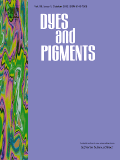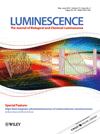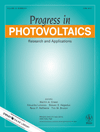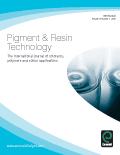
DYES AND PIGMENTS
metrics 2024
Connecting Researchers to the Heart of Color Chemistry.
Introduction
Dyes and Pigments, published by Elsevier Science Ltd, stands as a pivotal journal in the field of chemical engineering, particularly focusing on the realms of dyes and pigments as materials with extensive application across industries. Since its inception in 1980, this journal has evolved to capture cutting-edge research until 2024, making significant contributions to both the Chemical Engineering and Process Chemistry and Technology domains, where it currently ranks in the Q2 category. With an impressive Scopus ranking placing it among the top 82nd percentile in General Chemical Engineering and the top 73rd percentile in Process Chemistry and Technology, it demonstrates a robust commitment to publishing high-quality, impactful research. Although it does not offer an open-access option, its comprehensive content remains accessible to a wide audience of researchers, professionals, and students who are deeply engaged in the study and development of new dye and pigment technologies. Engaging with this journal not only enriches knowledge but also facilitates critical discussions that drive future innovations in chemical material sciences.
Metrics 2024
 0.67
0.67 4.10
4.10 3.70
3.70 142
142Metrics History
Rank 2024
Scopus
IF (Web Of Science)
JCI (Web Of Science)
Quartile History
Similar Journals

Bulletin of Chemical Reaction Engineering and Catalysis
Fostering Collaboration in Chemical Science DiscoveriesBulletin of Chemical Reaction Engineering and Catalysis is a distinguished open-access journal published by UNIV DIPONEGORO, focusing on pivotal advancements in the fields of chemical reaction engineering and catalysis. Since its inception in 2008, this journal has served as a vital platform for disseminating cutting-edge research, catering to a diverse readership that includes researchers, professionals, and students in chemical engineering and related disciplines. With its dedication to publishing valuable insights, the journal has been indexed in Scopus and boasts respectable rankings across various categories, including Q3 in Chemical Engineering (miscellaneous) and Q4 in Catalysis as of 2023. It continues to foster scholarly dialogue and collaboration by providing an accessible means for contributors to share their findings. Operating from Semarang, Indonesia, this journal underscores its commitment to advancing knowledge in chemical sciences, making it an essential resource for those engaged in the study and application of chemical processes.

CHINESE JOURNAL OF ORGANIC CHEMISTRY
Catalyzing Discoveries in Organic ChemistryThe Chinese Journal of Organic Chemistry, published by Science Press, serves as a pivotal platform for advancing the field of organic chemistry since its inception in 1996. With an ISSN of 0253-2786, this esteemed journal provides robust scientific contributions, reflecting significant advancements and novel findings that are crucial to the organic chemistry community. As of 2023, it is categorized in the Q3 quartile of organic chemistry journals, positioning it within the competitive landscape of this vibrant research area, ranking #147 out of 211 in Scopus, corresponding to a 30th percentile ranking. The journal is committed to fostering a scholarly exchange of ideas and research, making it an essential resource for researchers, professionals, and students dedicated to exploring the complexities and applications of organic compounds. The Chinese Journal of Organic Chemistry continues to support the dissemination of high-quality research that contributes to both local and global scientific endeavors.

Nanoscale Research Letters
Shaping the future through nanoscale discoveries.Nanoscale Research Letters, published by SPRINGER, is a leading open-access journal dedicated to the rapid dissemination of innovative research in the field of nanoscience and nanotechnology. Established in 2006, this journal provides researchers and professionals with a platform to share their groundbreaking findings across a broad spectrum of applications, including condensed matter physics and materials science. With an impressive Q1 ranking in both Condensed Matter Physics and Materials Science categories as of 2023, it asserts its position as a top-tier publication within the scientific community, bolstered by a 96th percentile rank in the Scopus database. Nanoscale Research Letters not only emphasizes the importance of nanotechnology research but also ensures that its findings are widely accessible, adhering to its open-access mandate. Scholars and students alike are encouraged to contribute to and engage with this dynamic resource, fostering collaboration and innovation in the ever-evolving world of nanoscience.

JOURNAL OF FLUORESCENCE
Harnessing Light for Scientific DiscoveryJournal of Fluorescence, published by Springer/Plenum Publishers, is a pivotal interdisciplinary journal focusing on the application and innovation of fluorescence methodology across various scientific domains. With an ISSN of 1053-0509 and an E-ISSN of 1573-4994, this journal facilitates the dissemination of significant research findings from 1991 to 2024. The journal has established itself as a key resource in fields such as Biochemistry, Clinical Biochemistry, and Spectroscopy, demonstrating its importance by maintaining a Q3 ranking in multiple categories in 2023, including Biochemistry and Clinical Biochemistry. While currently not offering open access, the journal's commitment to scholarly rigor is reflected in its Scopus rankings and diverse readership, making it an essential source of knowledge for researchers, professionals, and students engaged in the rapidly evolving landscape of fluorescence research.

ADVANCED FUNCTIONAL MATERIALS
Connecting Researchers to the Future of Materials ScienceADVANCED FUNCTIONAL MATERIALS is a leading journal published by WILEY-V C H VERLAG GMBH, prominently recognized in the fields of biomaterials, chemistry, condensed matter physics, and materials science. With an impressive impact factor and a distinguished position in the Q1 quartile across multiple categories including nanoscience and nanotechnology, this journal serves as a vital platform for researchers and professionals committed to innovating in functional materials. Since its inception in 2000, ADVANCED FUNCTIONAL MATERIALS has published high-quality peer-reviewed articles that push the boundaries of materials science, exploring new frontiers in electronic, optical, and magnetic materials. The journal's dedication to open access ensures that its groundbreaking findings are readily available to a global audience, fostering collaboration and knowledge-sharing among scholars and practitioners in the field. For those seeking to stay at the forefront of materials research, ADVANCED FUNCTIONAL MATERIALS is an essential resource.

LUMINESCENCE
Empowering Researchers to Illuminate New FrontiersLUMINESCENCE is a premier international journal published by WILEY, dedicated to advancing the field of luminescence and its applications across various scientific disciplines. With an ISSN of 1522-7235 and an E-ISSN of 1522-7243, this journal plays a pivotal role in disseminating high-quality research from 1997 to 2024. Positioned in the <> Q3 quartile within Biophysics and Q2 in Chemistry (miscellaneous), LUMINESCENCE ranks #37 out of 111 in its chemistry category and #57 out of 152 in biophysics, reflecting its significant impact in these domains. The journal facilitates open access, enabling wide visibility and engagement with groundbreaking research findings. Aimed at researchers, professionals, and students alike, LUMINESCENCE serves as a vital platform for sharing innovative studies and fostering collaboration in luminescence phenomena, thereby enhancing our understanding and utilization of this critical aspect of modern science.

Chemistry & Chemical Technology
Connecting Researchers to Shape the Future of Chemical SciencesChemistry & Chemical Technology is an esteemed academic journal published by LVIV POLYTECH NATL UNIV, specializing in the interdisciplinary intersections of chemistry and engineering. With its ISSN 1996-4196, this journal has become a significant platform, contributing to advancements and discussions within the fields of Chemical Engineering and Chemistry, as evidenced by its rankings in the 2023 category quartiles, where it is placed in Q3 for both disciplines. The journal aims to disseminate high-quality research articles, studies, and reviews from 2012 to 2024, welcoming contributions from researchers and professionals keen on driving innovation and fostering collaboration in the chemical sciences. As an open-access journal based in Ukraine, it has established a reputation for accessibility, providing comprehensive insights and a global perspective on the latest developments. Engaging with this journal not only enhances your understanding of current trends but also contributes to the global body of knowledge in chemical technology.

Materials Chemistry Frontiers
Exploring the Future of Materials ScienceMaterials Chemistry Frontiers, published by the esteemed Royal Society of Chemistry, stands as a leading journal in the realm of materials science and chemistry, with an impressive Q1 ranking in both Materials Chemistry and Materials Science categories as of 2023. This open-access journal, operating from the United Kingdom, offers a platform for researchers, professionals, and students to disseminate high-quality, impactful research. With its E-ISSN 2052-1537, the journal is dedicated to publishing cutting-edge articles, reviews, and research communications that explore innovative materials and their applications, fostering a comprehensive understanding of the complex interplay between materials and their chemical properties. With consistent rankings in the Scopus metrics, being positioned at the 25th percentile among 317 in the Materials Chemistry category, it highlights its pivotal role in advancing the field. The journal thrives on contributions that broaden the scope of knowledge from 2017 to 2024 and beyond, solidifying its status as an essential resource for contemporary research in materials science.

PROGRESS IN PHOTOVOLTAICS
Advancing Solar Solutions for a Sustainable FuturePROGRESS IN PHOTOVOLTAICS, published by Wiley, is a leading scholarly journal dedicated to the advancement of photovoltaic technology and its applications. Since its inception in 1993, this journal has maintained a strong focus on the latest developments in solar energy, addressing both theoretical and practical aspects of photovoltaic systems. With an impressive impact factor and consistently ranked in the Q1 quartile across four key categories—Condensed Matter Physics, Electrical and Electronic Engineering, Electronic, Optical and Magnetic Materials, and Renewable Energy, Sustainability, and the Environment—PROGRESS IN PHOTOVOLTAICS is regarded as a pillar of scholarly excellence. The journal is essential for researchers, professionals, and students who seek to stay at the forefront of innovations and sustainability in the energy sector. Although it does not primarily offer open access, its commitment to advancing the understanding of photovoltaic technologies ensures that readers can expect high-quality, peer-reviewed research that pushes the boundaries of current knowledge.

Pigment & Resin Technology
Transforming Ideas into Advanced Material SolutionsPigment & Resin Technology is an esteemed journal published by Emerald Group Publishing Ltd, focusing on the interdisciplinary fields of materials chemistry and coatings science. With a history spanning from 1972 to 2024, the journal serves as a vital platform for disseminating innovative research and developments concerning pigments, resins, and related materials technologies. Holding a respectable position in the Q3 category for both Materials Chemistry and Surfaces, Coatings, and Films as of 2023, it ranks within the 40th percentile among its peers, underscoring its relevance and impact within these domains. Although it does not currently offer open access, the journal remains a key resource for researchers, professionals, and students aiming to stay abreast of cutting-edge findings and practical applications in materials science. As such, Pigment & Resin Technology is essential reading for those engaged in the innovation and application of advanced materials in various industries.